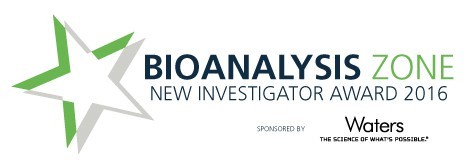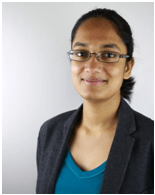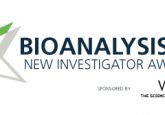2016 New Investigator: Agampodi Swarnapali De Silva Indrasekara

Nominated By:
Supporting Comments:
What made you choose a career in bioanalysis?
Growing up in a developing country, I have had a firsthand experience of the impact of inadequate health facilities and inaccessibility to affordable disease screening on human health. For instance, malaria was an epidemic in my nation that even affected me personally a few years ago. It was when I was in college taking chemistry that molecular biology classes made me realize my capability as a scientist to contribute to the pressing need to improve the global health. It lured me to pursue higher education in the (bio)analytical research field, where I now focus on developing point-of-care and detection tools.
Describe the main highlights of your bioanalytical research, and its importance to the bioanalytical community.
My research focuses have evolved around integrating inorganic nanomaterials for optics-based bioanalytical and biomedical applications. In particular, the development of effective metallic nanoparticle structures for Surface-Enhanced Raman spectroscopy (SERS)-based applications, and fabrication of simple, easy to perform nanoscale platforms have been the main areas of my specialization.
As a graduate student, I introduced a simple design of metallic nanoprobes that function as a versatile optical imaging tool for reliable, selective and ultrasensitive disease detection. Surface modification of nanoprobe via bioconjugations, I was also able to achieve highly sensitive SERS-based tumor imaging with nanomolar dosages of nanoparticles that outperformed fluorescence–based imaging. These nanoprobes are currently implemented to evaluate their effectiveness in image-guided tumor resection in ex vivo experiments.
I am also a co-inventor of a nanoscale platform that offers ultrasensitive (femtomolar) multiplexed SERS-based (bio)chemical detection. The simplified detection scheme of the nanoscale substrate requires only one-step processing. The extraordinary optical activity of star-shaped nanoparticles used in this platform offers label-free, rapid, positive-readout. This platform is in the process of implementing in point-of-care medical screening applications and potential commercialization. The promising results of the proof-of-concept nanoscale platform are the initiation of the yet to come many point-of-care and detection devices.
What is the impact of your work beyond your home laboratory?
Proof-of-concept nanoscale platform design for SERS-based (bio)chemical sensing applications has already shown promises in its potential for use in real world applications, where it has already granted US patent license.
In addition, the versatility of nanoscale materials developed for biosensing and bioimaging applications is reflected by their use in other scientific institutions for various research applications. For instance, the star-shaped SERS nanoprobes have been employed in the research work on the conservation of important pieces of artwork by Metropolitan Museum of Arts in NYC. The efficacy, sensitivity and selectivity of immunoassays for protein binders in artwork has been able to be boosted by many tens of folds using metallic nanoprobes. It is an example that outlines the highly transformative nature of my work on development and design of highly optically active nanoscale materials on direct and indirect bioanalytical research in many disciplines.
Describe the most difficult challenge you have encountered in the laboratory and how you overcame it.
I have never considered the problems I encountered in my research projects as challenges. From my perspective, overcoming so-called challenges or problem solving is the core of scientific research. The failures that lead me to alternative approaches are what makes me passionate to be a researcher.
However, early in my career as a novice graduate student, it was personally challenging for me to seek out the intellectual and material resources. It was the time when I received revisions for a manuscript, which required performing a new set of experiments using a Raman microscope. Unfortunately, at the same time, the laser source required for my experiments malfunctioned, and the estimated repair time passed the timeline for revisions. Being unable to find another instrument within the institution, and being restricted to use external paid facilities, this left me to feel helpless at that time. Instead of extending the revision time, I wanted to get it done in time. I then started to contact the labs in nearby institutions. I consider it as a milestone in my career where I first learned the art of research collaboration and negotiation. Finally, I was able to get the access to facilities in two institutions, and complete revisions in time.
Describe your role in bioanalytical communities/groups.
During my career, I have been mostly working in interdisciplinary research teams. As a chemist and material scientist, my expertise has been invested in developing nanoscale materials that display the physical and optical properties for the best performance in biochemical sensing, bioimaging and biomedical applications. For interdisciplinary research efforts, I provide my input in selecting the best-performing nanoscale materials and also work on optimizing the particle surface chemistry to meet the need of the ultimate bioapplication. As a postdoctoral researcher, I currently provide consultation for biomedical researchers in designing effective SERS substrate and device design for ultrasensitive, low-cost disease screening and immunotherapy platforms.
Besides that, planning towards my independent career as a research faculty in near future, I also work on formulating new optical detection concepts in molecular analysis. In this scenario, working with a team of biomedical engineers I take the opportunity to analyze and identify the significant problems in global health that can benefit from my research expertize. I am also involved with a global health initiative program, where I contribute to the design of affordable, easily operable nanoprobes for point-of-diagnosis and screening of parasite-borne infectious diseases.
Please list up to five of your publications in the field of bioanalysis:
- Indrasekara ASDS, Paladini B, Naczynski D, Moghe P, Fabris L. Dimeric gold nanoparticle assemblies as tags for SERS-based cancer detection. Adv. Healthcare Mater.2, 1370 (2013).
- Indrasekara ASDS, Meyer S, Shubeita S, Feldman LC, Gustafsson T, Fabris L. Gold nanostar substrates for SERS-based chemical sensing in the femtomolar regime. Nanoscale. 6, 8891 (2014).
- Indrasekara ASDS, Fabris L. The evolution of SERS tags toward genetic profiling. Bioanalysis 7(2), 263 (2015).
- Perets EA, Indrasekara ASDS, Kurmis A, Atlasevich N, Fabris L, Arslanoglu J. SERS-based immuno-nanosensors for robust localization of proteinaceous binders in artworks. Analyst doi:10.1039/C5AN00817D (2015) (Epub ahead of print)
- Dominguez-Medina S, Kisley L, Tauzin LJ et al. Adsorption and unfolding of a single protein triggers nanoparticle aggregation. ACS Nano. 10(2), 2103–2112 (2016).
Please select one publication from above that best highlights your career to date in the field of bioanalysis and provide an explanation for your choice.
The second publication best highlights my career in bioanalysis. This paper is based on the proof-of-concept type work, where a nanoscale platform is introduced for ultrasensitive spectroscopy-based detection of chemicals analogous to pesticides and toxins that affect the human health. The main reason to consider this work as the highlight of my career is because it introduces an easy to perform chemical screening platform with a multiplex quantitative readout that exhibits strong transformative potential in diagnostics and screening. I consider this work to have a broader impact in the bioanalysis field as this is reflected by the fast citations acquired by the paper.
Find out more about this year’s New Investigator Award, the prize, the judging panel and the rest of our nominees.



